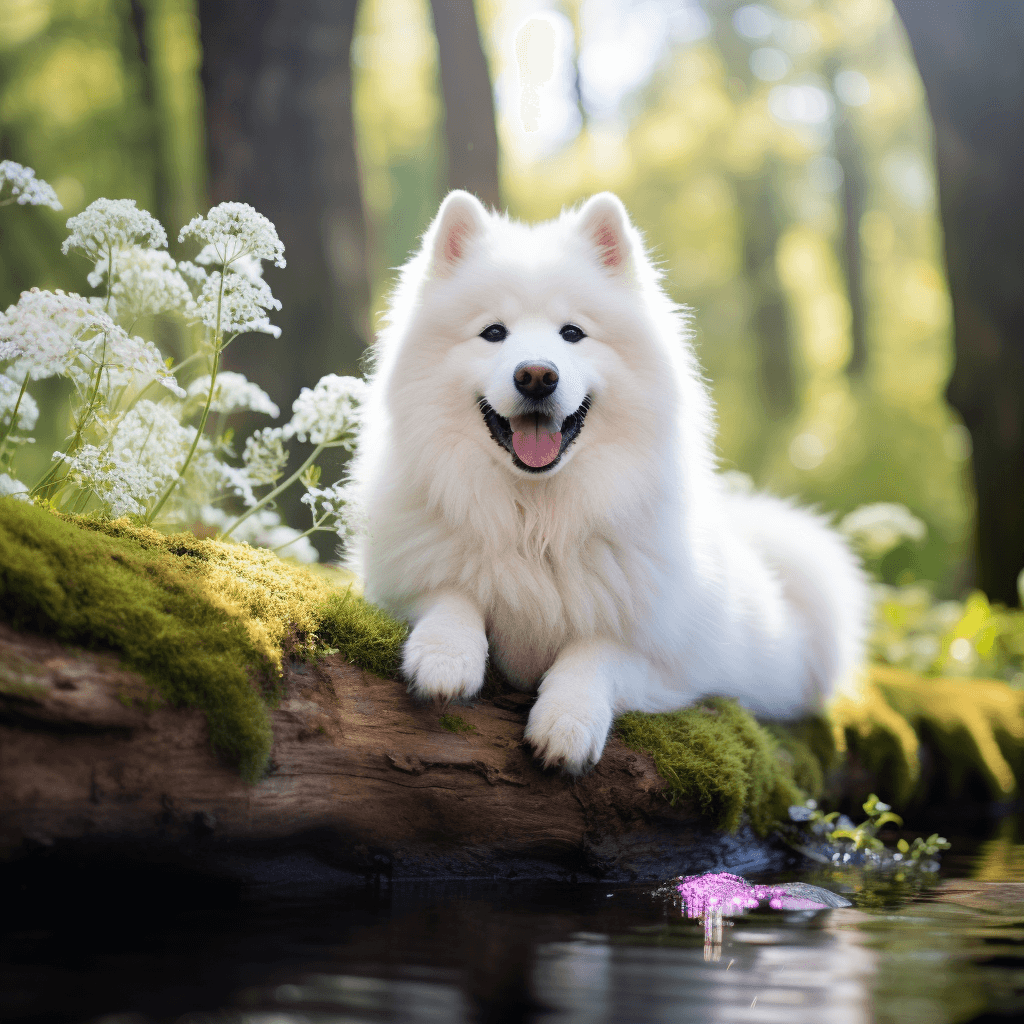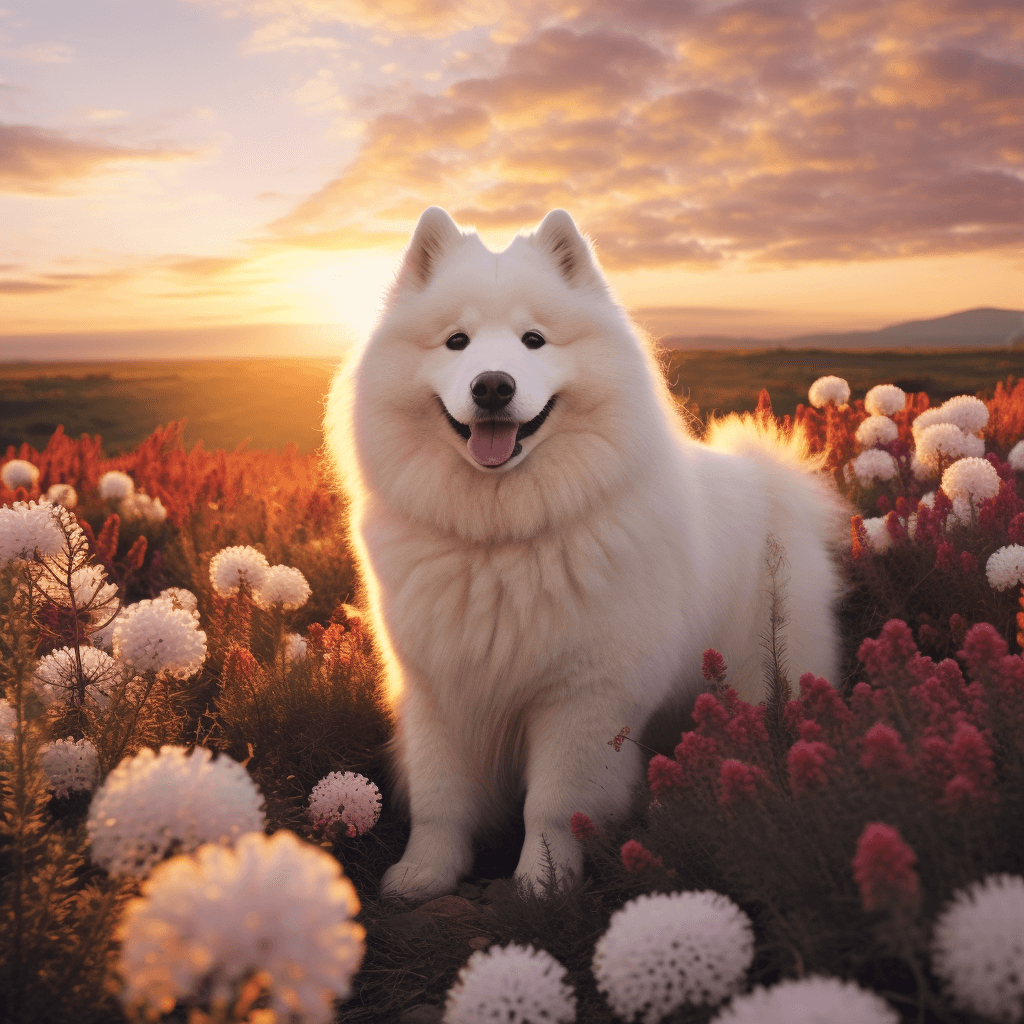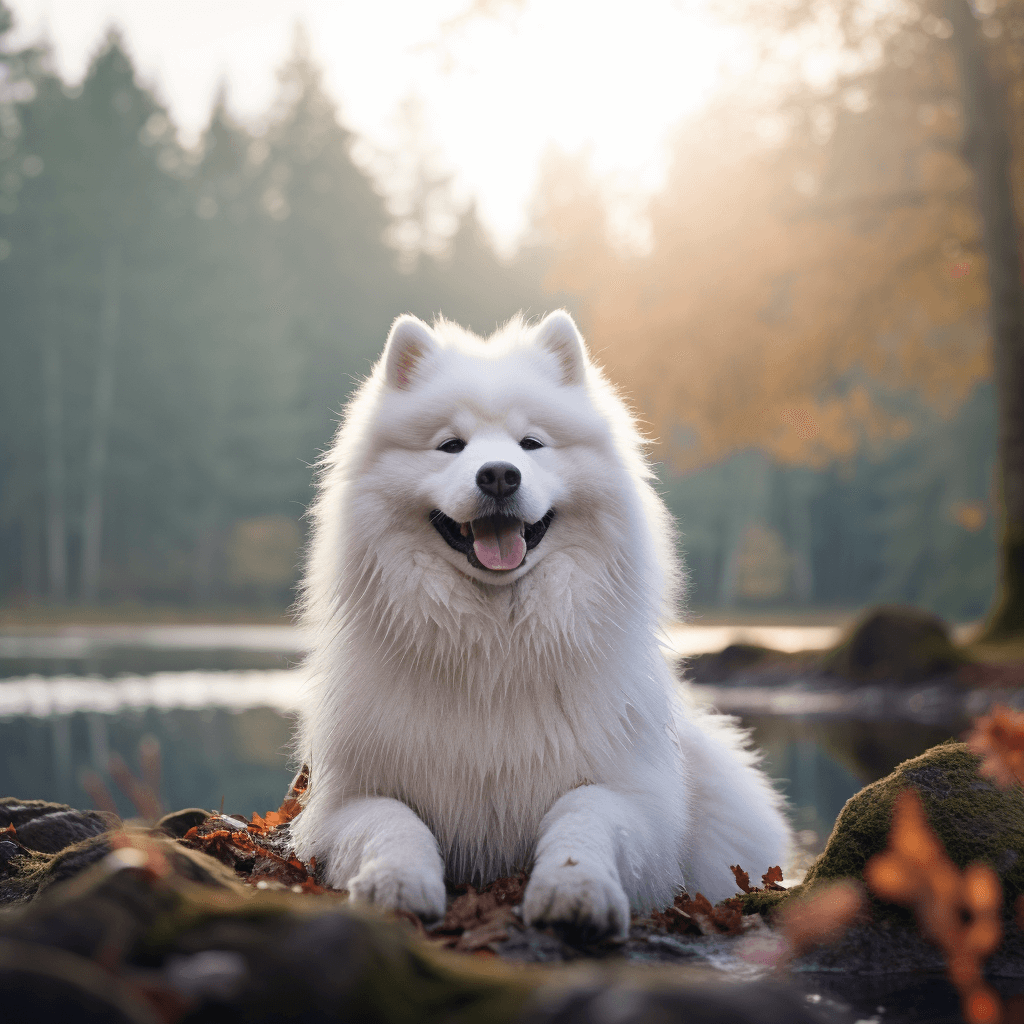The Samoyed is a fluffy, friendly, and intelligent breed known for its captivating smile. These dogs originate from Siberia, where the Samoyede people used them for herding reindeer and pulling sleds. Samoyeds are characterized by their thick double coat, which keeps them warm in cold climates. They are friendly and gentle dogs, making them excellent family pets. Samoyeds are also known for their "smile," as they often curl their lips to display their teeth, giving them an approachable and happy expression. They are highly sociable and thrive on human companionship, making them loving and loyal family members.

Group 5. Spitz and Primitive Breeds
Section 1. Northern Sled Dogs.
Without working trials.
BRIEF HISTORICAL SUMMARY
The name Samoyed comes from the "Samoyede" people who lived in Northern Russia and Siberia. In the southern regions of these areas, white, black, and brown-spotted dogs were used as herding dogs for reindeer, while in the northern areas, all-white dogs with moderate temperament were used for hunting and as sled dogs. Samoyed dogs lived alongside their owners, sleeping inside their dwellings and providing warmth.
British zoologist Ernest Kilburn Scott spent three months among the Samoyede tribes in 1889. Upon returning to England, he brought back a brown puppy named "Sabarka." Later, he imported a cream-colored female called "Belya Pecora" from the Western Urals and a snow-white male named "Musti" from Siberia. These dogs, along with a few others brought by later explorers, served as the foundation for the Western variant of the Samoyed breed. The first breed standard was written in England in 1909.
KEY PROPORTIONS
The length of the body is approximately 5% longer than the height at the withers, and the depth of the chest is slightly less than half the height at the withers. The length of the muzzle is approximately equal to the length of the skull.
GENERAL APPEARANCE
Medium-sized, elegant, white Arctic spitz. Gives the impression of power, endurance, charm, obedience, dignity, and self-assuredness. The so-called "Samoyed smile" is formed by the eyes' shape and placement and the mouth's slightly upturned corners. Sexual dimorphism is clearly expressed.
BEHAVIOR / TEMPERAMENT
Friendly, open, attentive, and lively. The hunting instinct is slightly pronounced. Not timid or aggressive. It is amicable and cannot be used as a guard dog.
HEAD
Massive and wedge-shaped.
CRANIAL REGION
Skull: Slightly convex when viewed from the front and in profile, broadest between the ears, with a slight groove between the eyes.
Stop: Noticeable but not sharply defined.
FACIAL AREA
Nose: The nose should be well-developed and predominantly black. In different seasons, the pigmentation may fade to what is called a "winter nose," but dark pigmentation must always be present around the edges of the nose.
Muzzle: Strong and deep, roughly equal in length to the cranial part; gradually narrows towards the nose, not pointed, heavy, or square; the nose bridge is straight.
Lips: Close-fitting, black, and quite thick. The corners of the mouth are slightly upturned, forming the characteristic "Samoyed smile."
Jaws / Teeth: Correct and complete scissor bite. Strong teeth and jaws. Full set of teeth.
Eyes: Dark brown, relatively widely spaced and deep-set, slightly slanted, almond-shaped. The expression is "smiling," friendly, lively, and intelligent. Eyelids are black.
Ears: Erect, reasonably small, thick, triangular, and slightly rounded at the ends; maybe mobile; set pretty high and wide on the broad skull.
NECK
Of medium length, muscular, with a proud carriage.
Section 1. Northern Sled Dogs.
Without working trials.
BRIEF HISTORICAL SUMMARY
The name Samoyed comes from the "Samoyede" people who lived in Northern Russia and Siberia. In the southern regions of these areas, white, black, and brown-spotted dogs were used as herding dogs for reindeer, while in the northern areas, all-white dogs with moderate temperament were used for hunting and as sled dogs. Samoyed dogs lived alongside their owners, sleeping inside their dwellings and providing warmth.
British zoologist Ernest Kilburn Scott spent three months among the Samoyede tribes in 1889. Upon returning to England, he brought back a brown puppy named "Sabarka." Later, he imported a cream-colored female called "Belya Pecora" from the Western Urals and a snow-white male named "Musti" from Siberia. These dogs, along with a few others brought by later explorers, served as the foundation for the Western variant of the Samoyed breed. The first breed standard was written in England in 1909.
KEY PROPORTIONS
The length of the body is approximately 5% longer than the height at the withers, and the depth of the chest is slightly less than half the height at the withers. The length of the muzzle is approximately equal to the length of the skull.
GENERAL APPEARANCE
Medium-sized, elegant, white Arctic spitz. Gives the impression of power, endurance, charm, obedience, dignity, and self-assuredness. The so-called "Samoyed smile" is formed by the eyes' shape and placement and the mouth's slightly upturned corners. Sexual dimorphism is clearly expressed.
BEHAVIOR / TEMPERAMENT
Friendly, open, attentive, and lively. The hunting instinct is slightly pronounced. Not timid or aggressive. It is amicable and cannot be used as a guard dog.
HEAD
Massive and wedge-shaped.
CRANIAL REGION
Skull: Slightly convex when viewed from the front and in profile, broadest between the ears, with a slight groove between the eyes.
Stop: Noticeable but not sharply defined.
FACIAL AREA
Nose: The nose should be well-developed and predominantly black. In different seasons, the pigmentation may fade to what is called a "winter nose," but dark pigmentation must always be present around the edges of the nose.
Muzzle: Strong and deep, roughly equal in length to the cranial part; gradually narrows towards the nose, not pointed, heavy, or square; the nose bridge is straight.
Lips: Close-fitting, black, and quite thick. The corners of the mouth are slightly upturned, forming the characteristic "Samoyed smile."
Jaws / Teeth: Correct and complete scissor bite. Strong teeth and jaws. Full set of teeth.
Eyes: Dark brown, relatively widely spaced and deep-set, slightly slanted, almond-shaped. The expression is "smiling," friendly, lively, and intelligent. Eyelids are black.
Ears: Erect, reasonably small, thick, triangular, and slightly rounded at the ends; maybe mobile; set pretty high and wide on the broad skull.
NECK
Of medium length, muscular, with a proud carriage.

BODY
Deep, compact, but flexible. The length of the body slightly exceeds the height at the withers.
Withers: Pronounced.
Back: Of medium length, muscular and straight; slightly longer in bitches than in males.
Loin: Short, powerful, and slightly arched.
Croup: Wide, strong, muscular, and slightly sloping.
Chest: Broad, deep, and long; in-depth, it almost reaches the elbows. The ribs are well-sprung.
Lower Line and Belly: Moderately tucked up.
TAIL
Set on high. In an alert state, the dog carries its tail rolled over the back or to the side, but at rest, it may drop and reach the hock joints.
FOREQUARTERS
General Appearance: Positioned under the body, with well-developed bone and musculature. When viewed from the front, they are straight and parallel.
Shoulders: Long, strong, and sloping.
Upper Arm: Approximately equal length to the shoulder blades, sloping, closely fitting against the rib cage.
Elbows: Close-fitting.
Forearm: Strong but flexible.
Pasterns: Slightly sloping.
Front Feet: Oval, with long, flexible toes pointing straight ahead. The toes are arched but not tightly bunched; the pads are springy.
HINDQUARTERS
General Appearance: When viewed from the rear, they are straight and parallel, with powerful musculature.
Thighs: Of medium length, relatively broad, and muscular.
Stifles: Well defined.
Hock Joints: Set relatively low and muscular.
Hocks: Short, strong, straight, and parallel.
Hind Feet: Similar to the front feet. Extra toes should be removed.
Deep, compact, but flexible. The length of the body slightly exceeds the height at the withers.
Withers: Pronounced.
Back: Of medium length, muscular and straight; slightly longer in bitches than in males.
Loin: Short, powerful, and slightly arched.
Croup: Wide, strong, muscular, and slightly sloping.
Chest: Broad, deep, and long; in-depth, it almost reaches the elbows. The ribs are well-sprung.
Lower Line and Belly: Moderately tucked up.
TAIL
Set on high. In an alert state, the dog carries its tail rolled over the back or to the side, but at rest, it may drop and reach the hock joints.
FOREQUARTERS
General Appearance: Positioned under the body, with well-developed bone and musculature. When viewed from the front, they are straight and parallel.
Shoulders: Long, strong, and sloping.
Upper Arm: Approximately equal length to the shoulder blades, sloping, closely fitting against the rib cage.
Elbows: Close-fitting.
Forearm: Strong but flexible.
Pasterns: Slightly sloping.
Front Feet: Oval, with long, flexible toes pointing straight ahead. The toes are arched but not tightly bunched; the pads are springy.
HINDQUARTERS
General Appearance: When viewed from the rear, they are straight and parallel, with powerful musculature.
Thighs: Of medium length, relatively broad, and muscular.
Stifles: Well defined.
Hock Joints: Set relatively low and muscular.
Hocks: Short, strong, straight, and parallel.
Hind Feet: Similar to the front feet. Extra toes should be removed.

GAIT / MOVEMENT
Powerful, accessible, energetic, with a long, sweeping stride, good reach in the front, and strong drive in the hindquarters.
COAT
Abundant, thick, dense, "polar." The Samoyed has a double coat: long, straight guard hairs that stand out and a short, soft, dense undercoat. The neck and shoulders have a "mane" of fur framing the head, more pronounced in males. The head, front of the legs, and feet are covered with close-fitting short fur. The fur on the outer sides of the ears stands out and lies flat on the inner sides. The rear thighs are covered with dense, long fur, forming "trousers." The hair between the toes protects the paws. The tail is bushy. In bitches, the fur is often shorter and softer than in males. With the correct coat structure, the Samoyed's fur always has a shiny sheen.
COLOR
Pure white, cream, or biscuit (the primary color must be white with a few biscuit spots). There should never be an impression of a pale brown color.
SIZE AND WEIGHT
The ideal height at the withers for males is 57 ± 3 cm, and for females, 53 ± 3 cm.
FAULTS / DEFECTS
Any deviation from the above points should be considered a fault/defect, and the seriousness with which it is regarded should be proportional to its degree of deviation and impact on the dog's health and well-being.
• Noticeable faults in the overall structure.
• Light bone structure.
• Poorly defined sexual dimorphism.
• Straight bite.
• Yellow eyes.
• Soft ear cartilage.
• Barrel chest.
• Tail curled into a double ring.
• Swayback.
• Pronounced barrel or cow-hocked stance.
• Wavy or short fur on the body, long, soft, or falling fur.
• Nervous behavior.
SERIOUS FAULTS / DEFECTS
• noticeable depigmented areas on the lips and eyelids.
DISQUALIFYING FAULTS
• Aggressiveness or timidity.
• Blue or differently colored eyes.
• Overshot or undershot bite.
• Ears not erect.
• Any color other than the standard.
Any dog that exhibits physical or behavioral deviations should be disqualified.
Note: Males should have two normal testicles fully descended into the scrotum.
Powerful, accessible, energetic, with a long, sweeping stride, good reach in the front, and strong drive in the hindquarters.
COAT
Abundant, thick, dense, "polar." The Samoyed has a double coat: long, straight guard hairs that stand out and a short, soft, dense undercoat. The neck and shoulders have a "mane" of fur framing the head, more pronounced in males. The head, front of the legs, and feet are covered with close-fitting short fur. The fur on the outer sides of the ears stands out and lies flat on the inner sides. The rear thighs are covered with dense, long fur, forming "trousers." The hair between the toes protects the paws. The tail is bushy. In bitches, the fur is often shorter and softer than in males. With the correct coat structure, the Samoyed's fur always has a shiny sheen.
COLOR
Pure white, cream, or biscuit (the primary color must be white with a few biscuit spots). There should never be an impression of a pale brown color.
SIZE AND WEIGHT
The ideal height at the withers for males is 57 ± 3 cm, and for females, 53 ± 3 cm.
FAULTS / DEFECTS
Any deviation from the above points should be considered a fault/defect, and the seriousness with which it is regarded should be proportional to its degree of deviation and impact on the dog's health and well-being.
• Noticeable faults in the overall structure.
• Light bone structure.
• Poorly defined sexual dimorphism.
• Straight bite.
• Yellow eyes.
• Soft ear cartilage.
• Barrel chest.
• Tail curled into a double ring.
• Swayback.
• Pronounced barrel or cow-hocked stance.
• Wavy or short fur on the body, long, soft, or falling fur.
• Nervous behavior.
SERIOUS FAULTS / DEFECTS
• noticeable depigmented areas on the lips and eyelids.
DISQUALIFYING FAULTS
• Aggressiveness or timidity.
• Blue or differently colored eyes.
• Overshot or undershot bite.
• Ears not erect.
• Any color other than the standard.
Any dog that exhibits physical or behavioral deviations should be disqualified.
Note: Males should have two normal testicles fully descended into the scrotum.